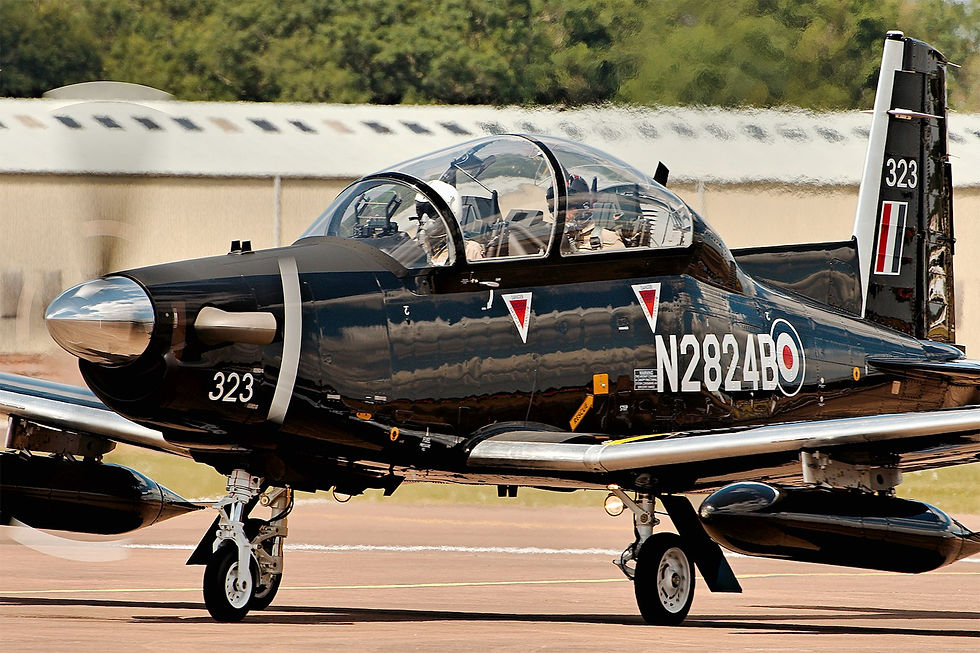Royal New Zealand Air Force Celebrates 40000 Flying Hours with T-6C Texan II Fleet
- Garth Calitz
- 1 hour ago
- 4 min read

The Royal New Zealand Air Force (RNZAF) is celebrating a significant milestone in its modern training era, as its fleet of Beechcraft T-6C Texan II aircraft surpasses 40,000 flying hours, equivalent to flying continuously for four and a half years.

Since their induction into the fleet in 2015, the Texans have become integral to New Zealand's military pilot training, operated by No. 14 Squadron at RNZAF Base Ohakea. These aircraft serve as the primary training platform for aspiring pilots and also support the Black Falcons, the Air Force's precision aerobatic display team.

Over the past decade, the Texan II has revolutionised pilot training in New Zealand. Since its introduction, 97 pilots have successfully earned their brevets, 91 from the Royal New Zealand Air Force (RNZAF) and the Royal New Zealand Navy, and six from the Royal Australian Air Force. This achievement highlights the platform’s reliability, versatility, and its essential role in developing the next generation of military aviators.


For many within the squadron, the Texan II represents a full-circle journey. Flight Lieutenant Corey Fothergill, who was among the first intake of students to train on the T-6C in 2016, is now one of the instructors guiding new trainees through the same course. “It’s definitely a full-circle sort of moment, which is cool,” he said, reflecting on how his journey has come full circle from trainee to instructor.

He remembers the first time he climbed into the cockpit as a student pilot. “It was overwhelming, it’s a mighty training aircraft for someone who hadn’t flown before. It was a humbling moment.”
After earning his Wings, Fothergill moved on to No. 3 Squadron, flying the NH90 helicopter, where he took part in operations in Australia and the Solomon Islands, as well as numerous search and rescue missions around New Zealand. Returning to No. 14 Squadron as an instructor, he says, has been deeply rewarding. “But being back at No. 14 Squadron for the past six months has been really rewarding,” he added. “You get to see the next generation of pilots start their journeys, and you know exactly what they’re going through.”


Among that next generation is Flying Officer Robert Petch, one of the squadron’s most recent graduates, who received his Wings in June. He describes learning to fly the Texan as “learning to drive in a sports car. No 14 Squadron takes you from having zero aviation experience to navigating at 250 feet and speeds of 210 knots,” he said.

His first flight brought with it a moment of sober reflection. “Ensuring the pin was pulled from the ejection seat in case of an emergency really hit home that this isn’t a simulator anymore,” he explained. For now, Petch will remain with the squadron as an instructor, passing on what he’s learned before moving on to a frontline operational role. He says the milestone of 40,000 flight hours is a testament to the tempo and precision of operations at No. 14 Squadron. “It’s impressive when you think about how many sorties we fly, typically 18 a day, sometimes up to 24,” he noted.


According to Squadron Leader Simon Isemonger, Officer Commanding No. 14 Squadron, the achievement reflects not only the dedication of pilots and instructors but also the world-class performance and reliability of the aircraft. “Our serviceability rates are among the highest in the world for this type,” he said. “We’ve worked through several significant issues over the past 10 years that an amazing team effort between our personnel, partners, and industry has resolved.”
The T-6C Texan II, manufactured by Textron Aviation Defence, is a modern, turboprop training aircraft featuring advanced avionics, a digital glass cockpit, and multi-function displays, giving students early exposure to the kind of systems they’ll encounter on frontline aircraft. “The Texan is ideal as a training platform,” said Squadron Leader Isemonger. “It offers a broad spectrum of flying disciplines, from instrument flying and formation work to low-level navigation. It prepares pilots well for whatever aircraft they move on to in the New Zealand Defence Force.”

With its robust design and extended range, the Texan II allows trainees to experience the full diversity of New Zealand’s airspace, from coastal routes to alpine terrain, providing valuable exposure to the country’s varied flying conditions.
The Royal New Zealand Air Force's (RNZAF) capacity to sustain exceptional performance and serviceability rates is attributed to a robust network of international partnerships. The Texan II training system in New Zealand is bolstered by Textron Aviation Defence, which provides the aircraft along with engineering and logistical support; Airbus, which is responsible for fleet maintenance and readiness; and CAE, which delivers advanced simulation and training systems.

These collaborations facilitate a seamless integration between live flight training and simulator instruction, enabling student pilots to acquire experience efficiently and safely. “This milestone is not just about the hours flown,” Squadron Leader Isemonger emphasised. “It’s about the teamwork, between our pilots, engineers, partners, and instructors, that keeps the fleet flying and the next generation of aviators progressing.”

The T-6C Texan II, beyond its function in training, represents the Royal New Zealand Air Force's commitment to public engagement through the Black Falcons, New Zealand's aerobatic display team. This team showcases the precision and professionalism of Air Force pilots at airshows and public events, inspiring future generations to consider careers in aviation.

Having accumulated 40,000 flying hours, the Texan II fleet has become a fundamental asset in New Zealand military aviation, serving as a crucial link between theoretical training and the operation of advanced aircraft. For the instructors and students of No. 14 Squadron, this milestone transcends mere numbers. It symbolises a decade of commitment, expertise, and collaboration, paving the way for a future characterised by exceptional aviation proficiency.



























Comments